Utica, NY: Major Milestones
Utica was shaped by transportation routes; first natural waterways, roads (military variety first), stagecoach lines, canals, railroads, streetcars and trolleys, and finally modern highways. Airport and airlines played a role as well, as did buildings, bridges, and of course business establishments.
As we will show, the appearance, destruction/disappearance and or relocation of all these had major impacts in Utica's development. Another resource focuses on Utica's Urban Renewal phases.
Also, another page tracks Downtown Utica Developments.
1754 to 1760 - French and Indian War.
1758 - In this year Fort Schuyler was constructed on banks of the Mohawk River, just north-east of our current-day Union Station.
1788 - First inhabitant, started what became a settlement when Major John Bellinger built a permanent structure near current day Washington and Whitesboro Streets.
1794 - Stagecoaches start running through and out of Utica.
1797 - New York State commissioned two roads; from Fort Schuyler west to the Genesee River (Genesee Road), and from Fort Schuyler to Albany (State Road). In this same year the Holland Land Company built a hotel near Bagg's Square. This hotel was proceeded by Moses Bagg who brought his family in 1794 to open a blacksmith shop, followed by his inn in 1795. After his father's death, Moses Bagg, Jr took over the tavern in 1805.
1798 - Now called Old Fort Schuyler, the village is incorporated and named "Utica".
1802 - Below, map of Utica shows only two roads intersecting at Bagg's Square. Baggs Hotel on the square, and 81 homes mostly south of the Mohawk River.
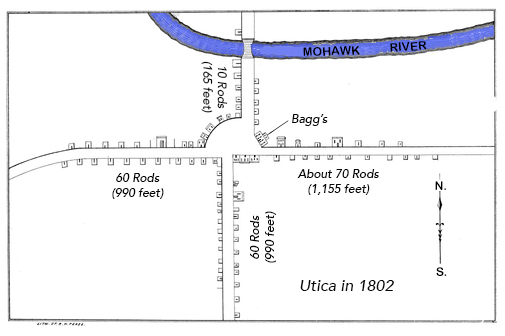
Present day roads on these routes would be Genesee Street (running north to south), Main Street (heading towards the east), and Whitesboro (leading out to the west). By 1806 more developments occurred and Hotel and Seneca streets were added.
1808 - Liberty Street placed on record.
1817 - Construction of the Erie Canal is started, it will run a length of 363 miles (584 km) from Albany (the Hudson River) to Buffalo (Lake Erie).
1825 - Utica (Population 5,040) has a network of streets as the Erie Canal's construction is completed and helps the city grow in both the east and westerly directions. Started in Rome, the first stretch reached Utica in 1819.
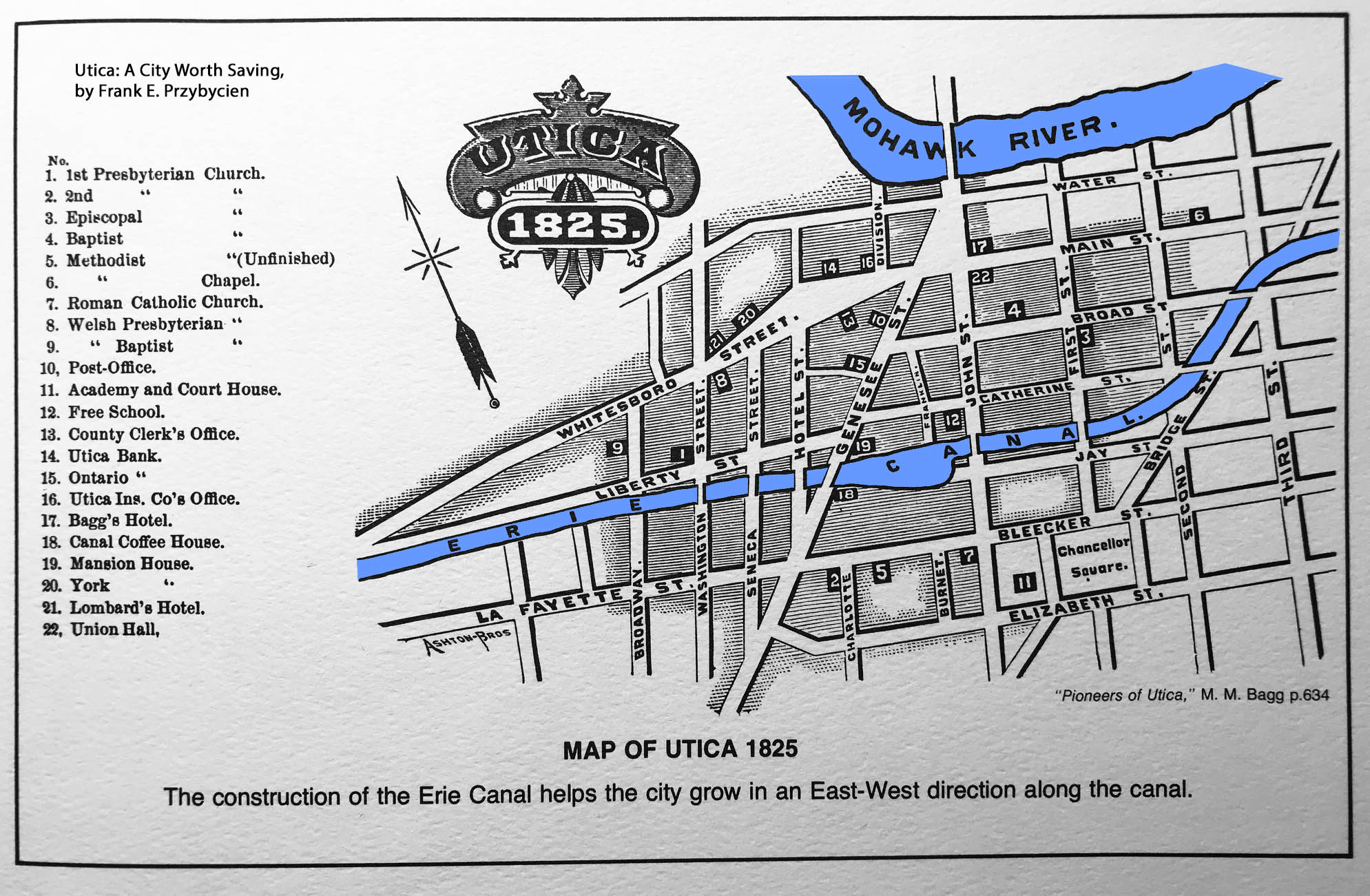
1832 - Utica becomes a City...
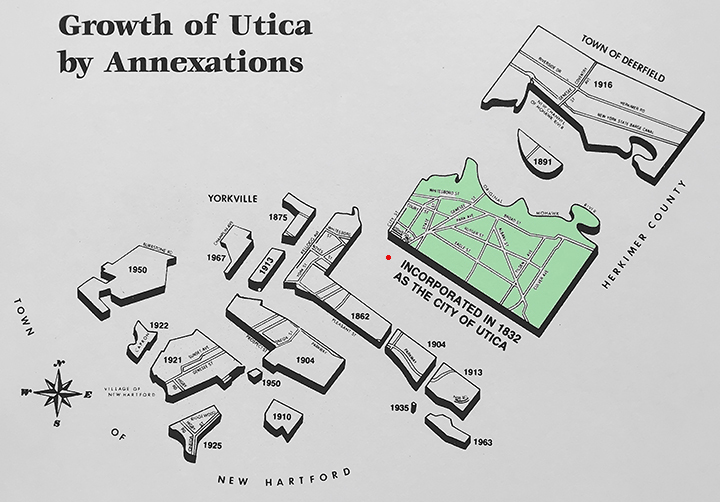
1833 to 1836 - These are the start and completion years of the north to south, Utica-to-Binghamton, Chenango Canal. For much of the course, it followed the Chenango River. As talks about its creation were started, some 1,830 residents of the Chenango Valley wanted the canal. Final cost was over $2.5M and covered 97 miles, via 116 locks.
1845 to 1950: Utica, “Knit goods capital of the world”
"Utica was labeled “knit goods capital of the world.” 24+ mills employed thousands of men and women. The recommendations of three men in 1845 launched the Textile Era in the Upper Mohawk Valley region. This industry dominated locally for 100 years, until the 1950s when many of the mills moved south."
1845 - Move to convert Utica Mills to Steam power "For first time in 40 year, city’s knitting mills were closing or laying off workers, population was dropping. Our mills had machines that were operated manually or with water power. Three Utica men (a merchant, a lawyer and an industrialist) wrote a report for area owners of factories and knitting mills. The recommendations they made changed the lives of Uticans and their neighbors for the next 100 years. Utica had one big advantage over New England, too, since the recently completed Chenango Canal connected it to the coal fields of Pennsylvania.", as reported in, Steam Becomes Savior of Area Mill Industry.
1862 - Thirty years after becoming a City (in 1832), first annexation occurs in 1862...
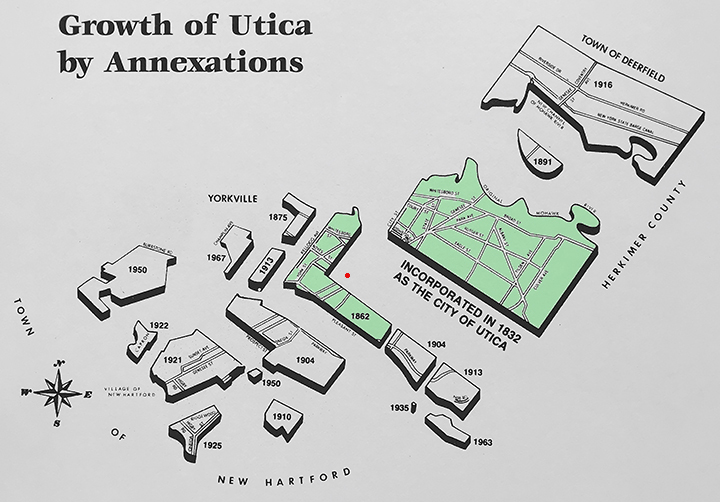
City of Utica, 1st Annexation: 1862
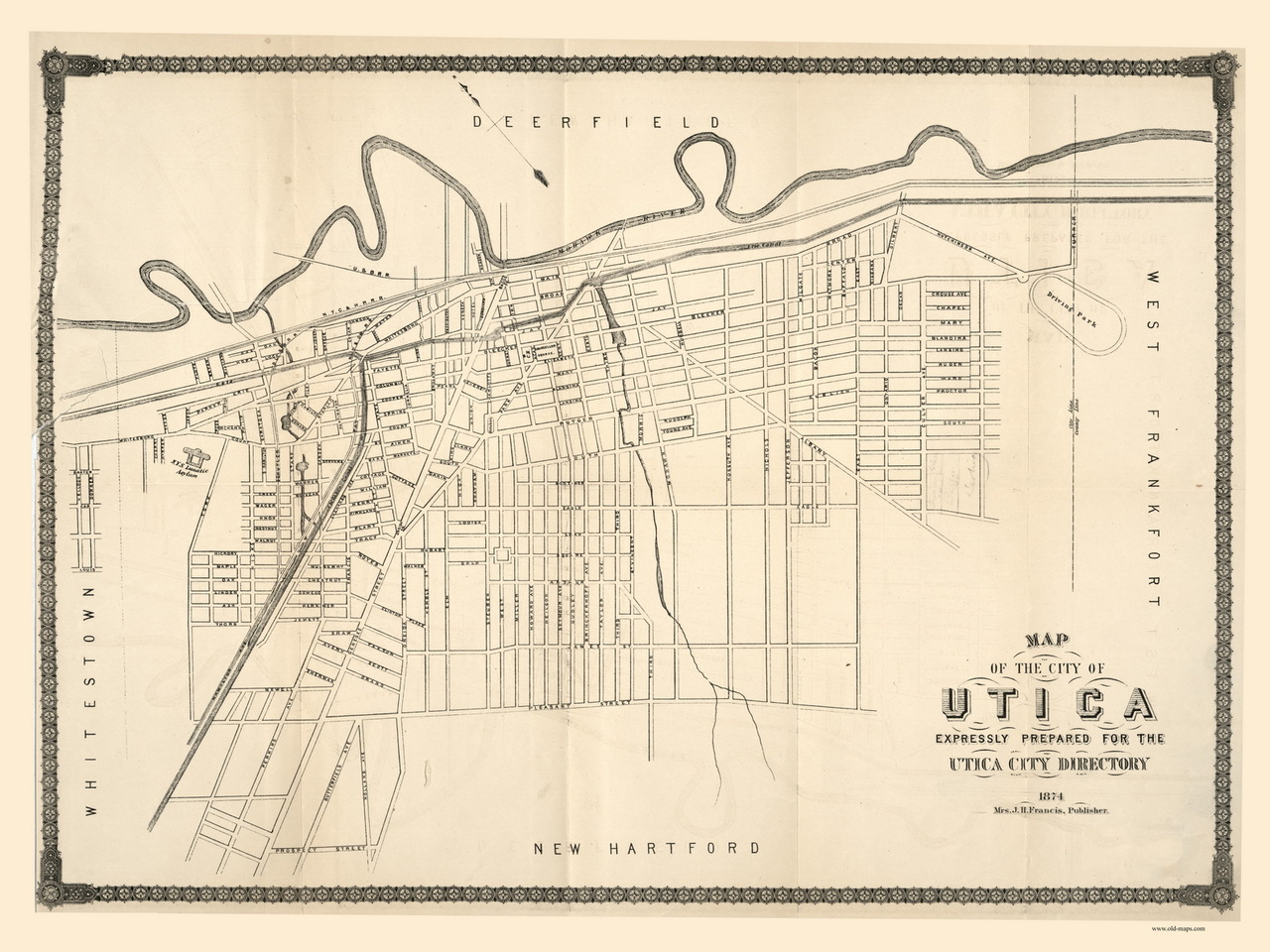
1875 - The City of Utica grows again with annexation number two...
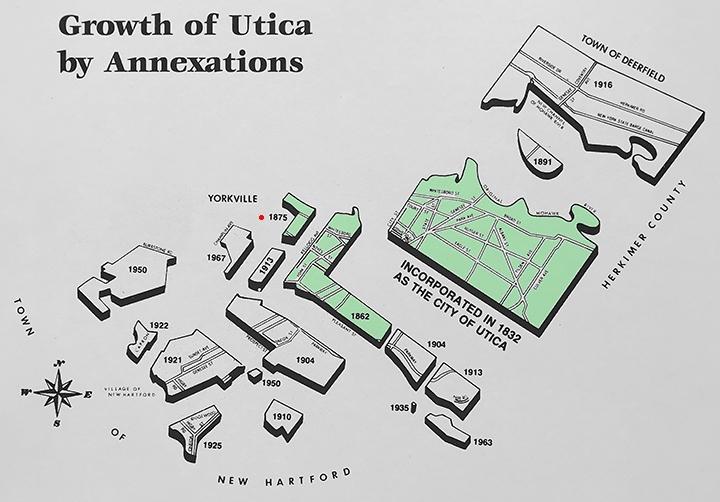
City of Utica, 2nd Annexation: 1875
1891 - Growth of City with third annexation...
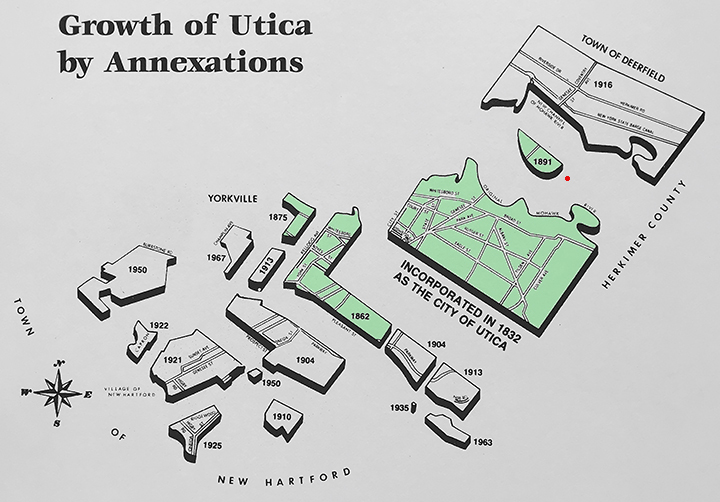
City of Utica, 3rd Annexation: 1891
????????? to ?????????
1901 - In this year a vote casted the decision to reroute the Mohawk River north away from the railroad tracks. The work was completed in 1907.
1904 - City continues growing with a fourth annexation, of two additional tracts of land...
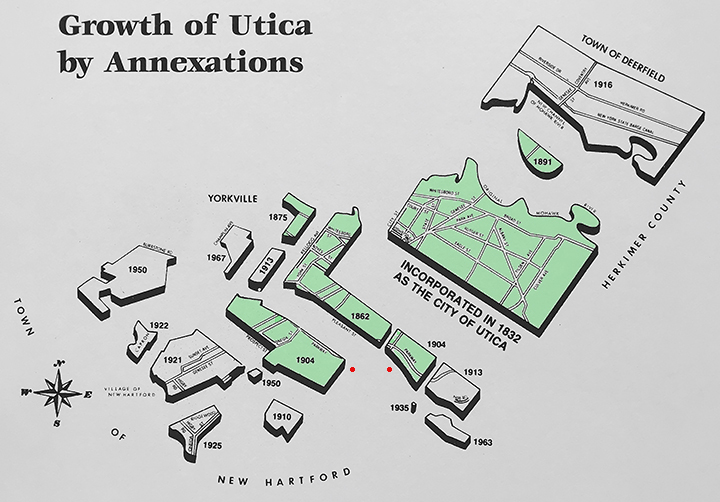
City of Utica, 4th Annexations: 1904
1905 - The song "Low Bridge, Everybody Down", by Thomas S. Allen, popular the Eire Canal: "...after Erie Canal barge traffic was converted from mule power to engine power, raising the speed of traffic. Also known as "Fifteen Years on the Erie Canal", "Fifteen Miles on the Erie Canal", "Erie Canal Song", "Erie Barge Canal", and "Mule Named Sal", the song memorializes the years from 1825 to 1880 when the mule barges made boomtowns out of Utica, Rome, Syracuse, Rochester, and Buffalo, and transformed New York into the Empire State. The tune is sadly nostalgic." Current day musician, Bruce Springsteen, continued to popularize the world famous canal with his Seeger Sessions Band.
1910 - Growth advances with a fifth annexation...
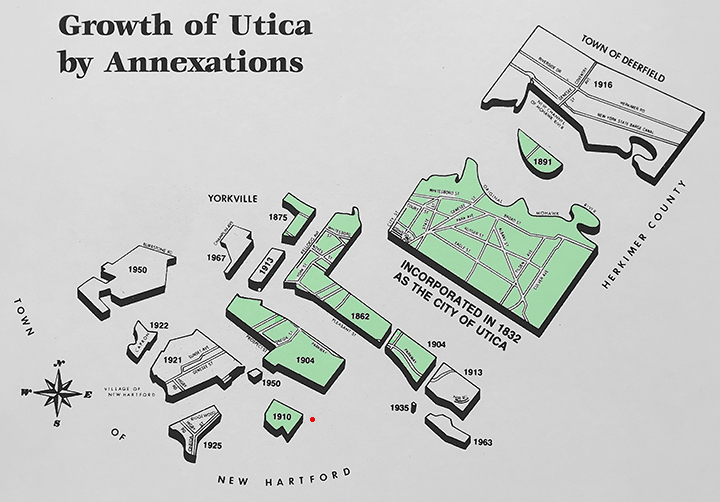
City of Utica, 5th Annexation: 1910
1913 - A sixth annexation of another two tracts of land further expands size of Utica further south...
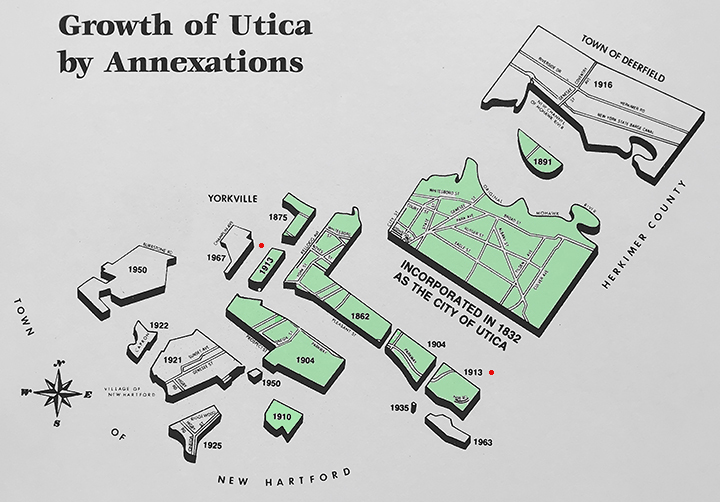
City of Utica, 6th Annexation: 1913
1914 - Utica had railroads galore: the 1) Delaware, Lackawanna & Western; 2) the New York, Ontario & Western; 3) the Rome, Watertown & Ogdensburg; and the 4) West Shore and the New York Central.
1916 - Seventh annexation as Utica grows to north with major expansion...
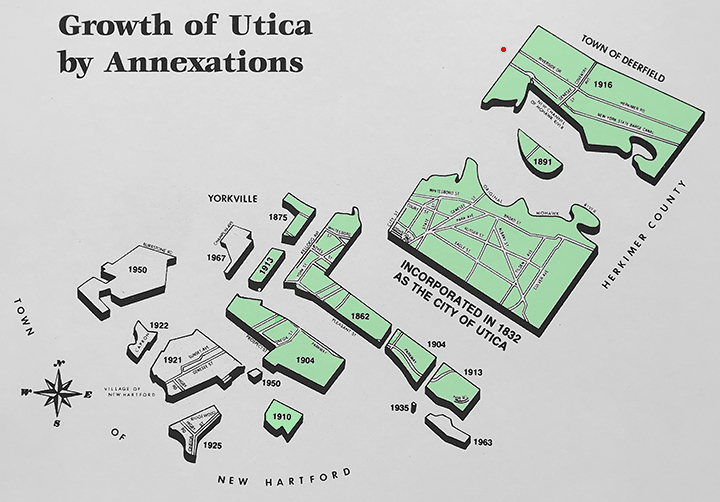
City of Utica, 7th Annexation: 1916
1917 - One hundreds later, in this year, the Eire Canal ceased operation as the "New York Barge Canal" opened; see New York State Canal System.
1921 - Utica has eight annexation, stretching further south...
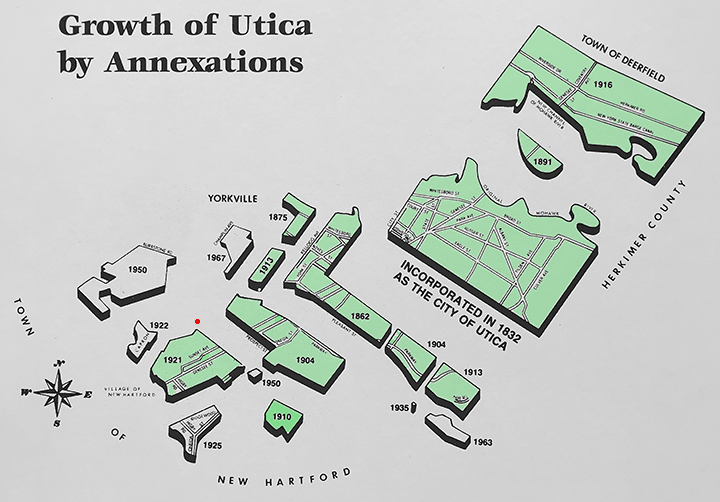
City of Utica, 8th Annexation: 1921
1922 - Utica's ninth annexation...
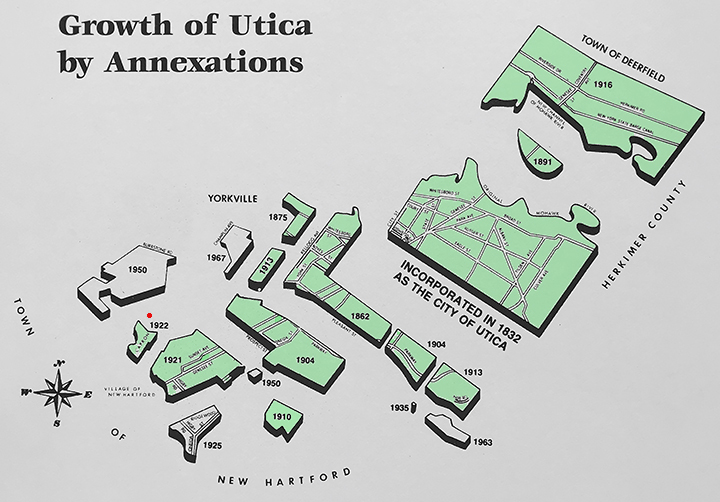
City of Utica, 9th Annexation: 1922
1925 - Utica's 10th annexation keeps city expanding...
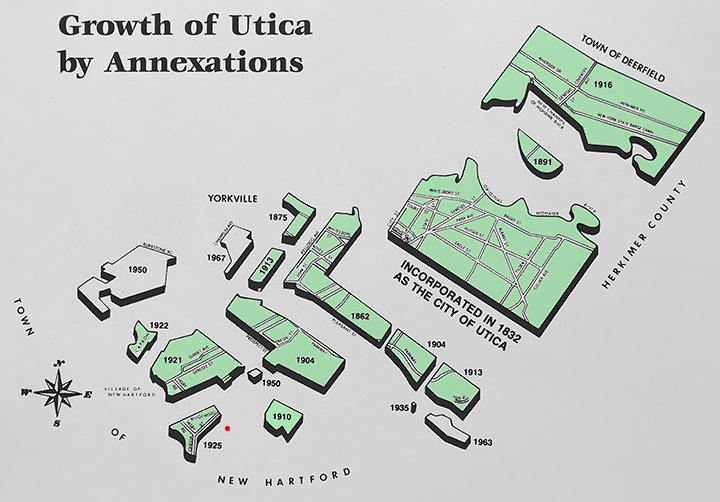
City of Utica, 10th Annexation: 1925
1928 - Stanley Theater opens on Monday, Sept. 10, 1928
1935 - Utica's 11th annexation keeps city expanding...
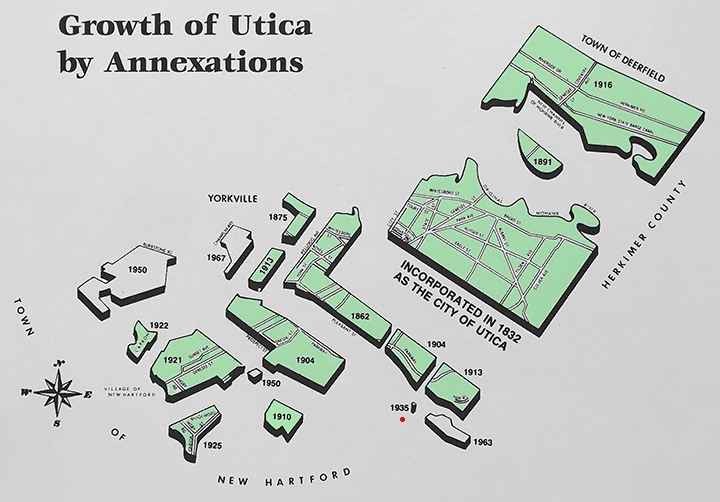
City of Utica, 11th Annexation: 1935
1950 - Two more parcels are annexed to Utica...
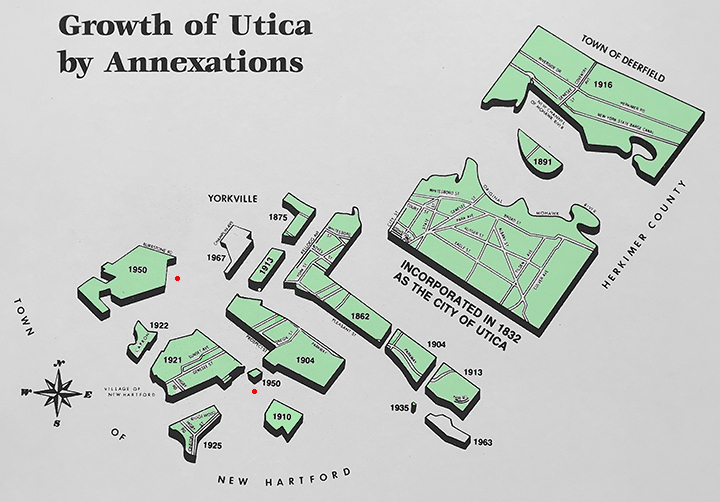
City of Utica, 12th Annexation: 1950
1963 - Annexation occurs in utica...
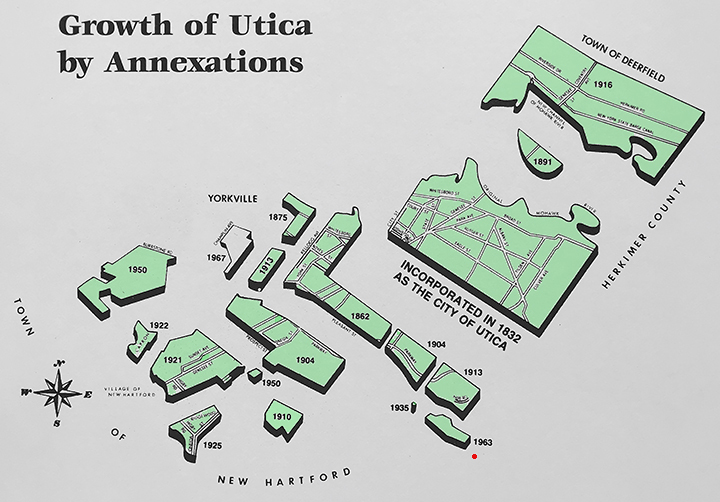
City of Utica, 13th Annexation: 1963
1967 - Annexation occurs in utica...
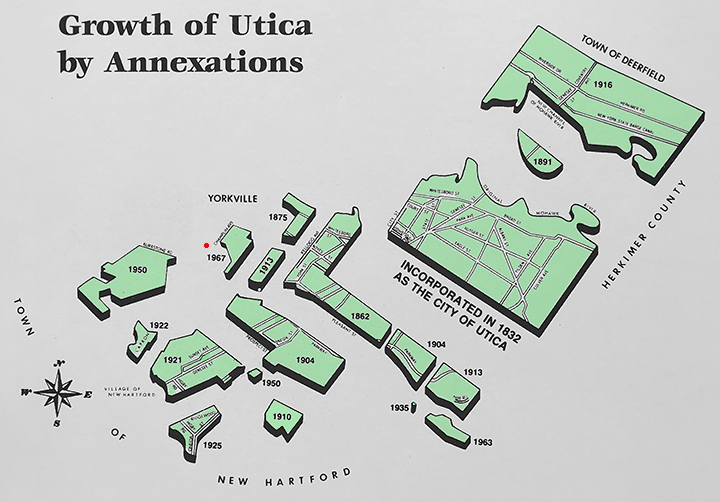
City of Utica, 14th Annexation: 1967
???? - State and County Office Buildings are built .
???? - East-west Oriskany Boulevard highway created.
???? - Griffith Air-force Base.
1974 - Oneida County's first mall, Riverside Mall, opens this year in August.
???? - Erie Canal relocated out of Downtown Utica, was moved and enlarged, as it was pushed northward into North Utica.
1878 - The Chenango Canal ceased operation ending a significant link in the water transportation system of the northeastern U.S., which had connected the Susquehanna River to the Erie Canal.
1945-1955: Utica’s “Loom-to-Boom” Era
1944 - General Electric opens radio tube plant employing 250 people at Bleecker and Kent streets. This as recalled here, on news that GE might return (2015), Will GE bring good things to life again in area?.
1945 - World War II ended in August. Utica factories and knitting mills, which had spent the last five years manufacturing goods for the military, began to lay off hundreds of workers - unemployment rate soars to 15 percent.
In the years after World War II, GE added larger operations at the intersection of Bleecker and Culver Avenue, as well as leases space in old mill buildings on Broad Street.

1948 - The Chicago Pneumatic Tool was approached in 1947, as textile mill employment was falling. In 1948 Chicago Pneumatic opened with 2,500 employees, 1950's Boom-era Began With Chicago Pneumatic.
???? - Bendix Aviation locates plant on Seward Avenue in South Utica, XXX jobs are created as plant starts producing XXXX.
1951 - General Electric builds a $15 million plant on French Road.
1980 - "Mill Square" Brodock Press owner undertook the redevelopment of the State Street Mill while Stephen Pawlinga was Mayor of Utica.
1992 - General Electric leaves Utica.
2001 - Hotel Utica purchased for restoration
? - Utica National builds downtown
2003 - In an effort to relocate the Washington Courts Municipal Housing complex, the city and the Housing Authority pursued HUD HOPE VI funding as a means to provide replacement housing. In early 2003 the city was notified by HUD that it was successful in its $11.5 million dollar HOPE VI application which will allow for approximately 195 low income rental and homeownership units to be built or rehabilitated in the distressed Cornhill area. [Ref.]
2005 - The City of Utica Police Department opened its new fleet maintenance facility last month, taking approximately seven months to construct... part of Utica's Gateway District project.
2011 - Kennedy Plaza redeevlopment, $20,000,000 invested, read Extreme makeover: Kennedy Plaza edition.
2017 - The Utica Observer-Dispatch offers many photographs, as they reflect on the Erie Canal's 200 Birthday
2018 - Former Tartan Texile plant beside AUD is demolished, [Ref.]
References
Past: How a mill town survived without mills
We're not opposed to a new hospital, just do not bulldoze Downtown Utica's Historic Columbia-Lafayette Neighborhood... "Build It At St. Luke's!"